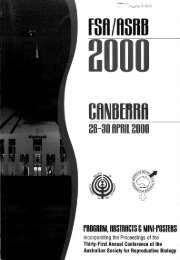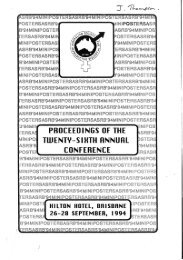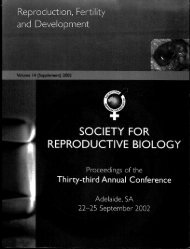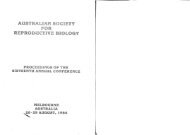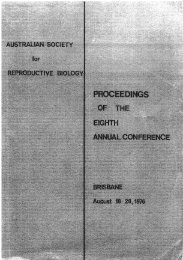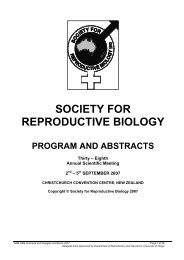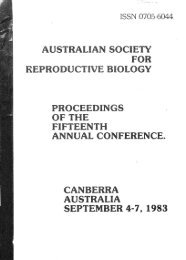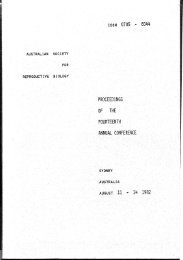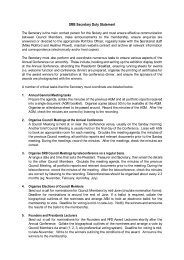N OCIETY' - the Society for Reproductive Biology
N OCIETY' - the Society for Reproductive Biology
N OCIETY' - the Society for Reproductive Biology
You also want an ePaper? Increase the reach of your titles
YUMPU automatically turns print PDFs into web optimized ePapers that Google loves.
Implantation and transplantation: endocrine signals in cell lineage choiceJohn P. HearnResearch School of Biological Sciences, Australian National UniversityPO Box 475, Canberra, ACT 2601, AustraliaTHE DEVELOPMENT AND POTENTIAL USE OF HUMAN EMBRYONIC STEM CELLSIntroduction:The rapid establishment of embryo-maternalatr~;;:'hment, implantation and differentiation at <strong>the</strong>stan of pregnancy is enabled by an endocrinedialogue. The reliance on chorionicgonadotrophin (CG) as an embryonic signal ofviability, and capacity to support <strong>the</strong> corpusluteum, is apparently restricted to primates. Wequestioned <strong>the</strong> possible role of gonadotrophinreleasing hormone (GnRH) in regulating CGrelease during implantation. fu associated studies(with James Thomson, University of Wisconsin)we isolated and characterised <strong>the</strong> similarities inendocrine secretion from totipotent or pluripotentembryonic stem cells in marmoset and rhesusmonkeys.Materials and Methods:The development of non-surgical embryorecovery, microassays to measure GnRH and CG,and embryo culture to <strong>the</strong> in vitro equivalent ofday 12 after embryo attachment, were describedearlier (1,2,3). fu current studies we incubatedsingle embryos with exogenous GnRH, agonist orantagonist, measuring <strong>the</strong> resulting change in CGsecretion and <strong>the</strong> differentiation stages ofembryos. In addition, embryonic stem cells wereisolated (4,5) and <strong>the</strong>ir secretion of CG monitored.Results:Control embryos (n=25) secreted a characteristicprofile of CG, with GnRH measurable in <strong>the</strong>culture fluid by mid blastocyt stages ofdevelopment. fucubation with antagonist (n=15)reduced CG secretion and slowed differentiation.fucubation with agonist (n=15) enhanced CGsecretion but drastically inhibited attachment anddifferentiation. fucubation with exogenous GnRH(n=10) greatly enhanced both CG secretion andembryo differentiation, suggesting an unexpectedstimulus to embryo survival, with possible<strong>the</strong>rapeutic implications. Differentiatedembryonic stem cells also secreted CG andmaintained <strong>the</strong> developmental potential to <strong>for</strong>mtrophoblast and all three embryonic germ layers.Discussion:Our results suggest a direct or indirect function<strong>for</strong> GnRH, secreted by <strong>the</strong> embryo during periimplantationstages of pregnancy, in <strong>the</strong>regulation of CG secretion. There may also bedirect effects on cell growth anddifferentiation. The ability to enhance ordiminish embryo attachment, outgrowth anddifferentiation may provide a novel (andcontrolled) approach to study intra-embryoniccell signalling by stimulating or inhibitingperi-implantation events (6,7). In embryonicstem cell preparations, using a similarapproach, it may be possible to dissectgenetically in vitro <strong>the</strong> mechanisms controllingprimitive streak <strong>for</strong>mation in primates and <strong>the</strong>endocrine signals that influence choice in celllineage.References:1. Hearn JP et al (1994) In: Marshall'sPhysiology of Reproduction, 4 th Ed. Pp.535-676, Chapman and Hall, London2. Webley, GE and Hearn JP (1994) Ox<strong>for</strong>dReviews of <strong>Reproductive</strong> <strong>Biology</strong> 16: 1-323. Seshagiri, PB, Terasawa, E and Hearn, JP(1994Hum.Reprod.91300-1307.4. Thomson JA, Hearn JP et al. (1995)Proceedings of <strong>the</strong> National Academy ofSciences 92: 7844-7848.5. Thomson, JA, Hearn, JP et al (1996) Biol.Reprod. 55, 254-259.6. Hearn, JP (1997) Endocrine Signals inembryo implantation In Marsupial biology,recent research, new perspectives, pp 22-30UNSW Press, Sydney7. Stouffer, RL and Hearn, JP (1998) In: TheEndocrinology of Pregnancy. Pp 35-57Humana Press, NJ. t-\rfiJ\\ C.,.!t'l{ 'j\ ,'." . /~I'i,~(2)(3)Ben Reubinoff l ,2, Martin Pera l , AriffBo~gs03, Chui Fong 3 and Alan Trounson lICentre <strong>for</strong> Early Human Development, fustitute of Reproduction and Development, MonashUniversi~, 2Department of Obstetrics and Gynecology, H~dassah l!niv~rsity H?spital, Israel andDepartment of Obstetrics and Gynaecology, NatIonal UnIverSIty of SIngaporeHuman embryos can be grown to <strong>the</strong> blastocyst s.tage efficie~tly in ~itro (1) and. will ~ttach t~ andoutgrow in plastic culture dishes in vitro (2). It IS also pOSSIble to Immunosurgically Isolate ~nnercell mass cells (ICM) of human blastocysts and to maintain <strong>the</strong>se cells in long-term culture 10 anundifferentiated state. The isolation and passage of undifferentiated human embryonic cells waspublished by Thomson et al. (3). We have independently derived undiffere~tiat~d human embryoniccells that maintain <strong>the</strong>ir phenotype through extended culture and passage In VItro. These cells aremultipotential and are able to differentiate in vitro and when ~enotra~s~lanted in~o ,a ~ery. widerange of cell and tissue types. The multipotentiality of <strong>the</strong> dIfferentIatIng cells IS IndIcatIve ofembryonic stem cells.The potential value and use of embryonic stem cells are <strong>for</strong> <strong>the</strong> d~t~rminat~on of. <strong>the</strong> int~in.sic andextrinsic factors that direct lineage specific differentiation. The abIlIty to dIrect dIfferentIation andto maintain stem cell phenotype during large scale multiplication may enable <strong>the</strong>se cells to be used<strong>for</strong> transplantation, be used <strong>for</strong> tissue engineering and gene <strong>the</strong>rapy.The research with <strong>the</strong>se putative embryonic stem cells is presently aimed to identify <strong>the</strong> factorsinvolved in <strong>the</strong> maintenance of stem cell phenotype and those involved in <strong>the</strong> check points directingearly differentiation events.References(1)Jones GM, Trounson AO, Lolatgis N, Wood C (1998) Factors affecting <strong>the</strong> success ofhuman blastocyst development and pregnancy following IVF and embryo transfer. FertH.Steril. 70: 1022-29.Bongso A, Fong C-Y, Ng SC, Ratnam S (1994) Isolation and culture of inner cell mass cellsfrom human blastocysts. Human Reprod. 9: 2110-17.Thomson JA, Itskovitz-Eldor J, Shapiro SS, Waknitz MA, Swiergiel JJ, Marshall VS, JonesJM (1998) Embryonic stem cell lines -derived from human blastocysts. Science 282 (5391):1061-62.66""""-~G67



